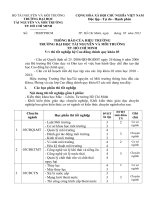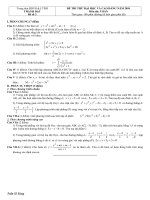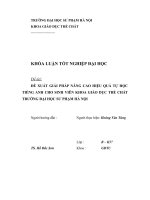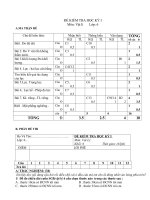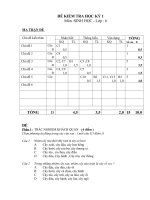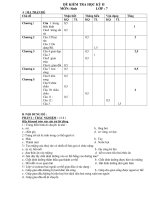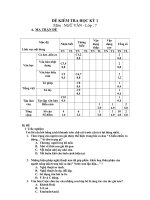Dhtdt ctrr lecture 03 (2)
Bạn đang xem bản rút gọn của tài liệu. Xem và tải ngay bản đầy đủ của tài liệu tại đây (7.37 MB, 202 trang )
<span class="text_page_counter">Trang 1</span><div class="page_container" data-page="1">
DISCRETE STRUCTURES Sets
TS Nguyễn Thị Huỳnh Trâm
<small>1</small>
</div><span class="text_page_counter">Trang 2</span><div class="page_container" data-page="2">Predicates Statements
1) Predicates Statement: Assign specific values to all their variables.
2) Statement predicates: removing some or all of the nouns from a statement
Nam is a student at TDTU
<small>Statement Mệnh đề (Có thể xác định được chântrị 1 hoặc 0)</small>
P(x) = “x is a student at TDTU”Q(x, y) = “x is a student at y”R(x, y, z) = “x is z at y”
<small>Predicate variables P(x) Biến vị từ</small>
<small>P,Q,R are predicate symbols </small>
<small>ký hiệu vị từ</small>
<small>2</small>
</div><span class="text_page_counter">Trang 3</span><div class="page_container" data-page="3">• Definition (Predicate): A predicate is a sentence that contains a finite number of variables and becomes a statement when specific values are substituted for the variables.
• The domain of a predicate variable is the set of all values that may be substituted in place of the variable
P(x) = “x is a student at TDTU”Q(x, y) = “x is a student at y”R(x, y, z) = “x is z at y”
<small>students at CSstudents at TDTU</small>
<small>students at UL</small>
<small>z </small>
<small>3</small>
</div><span class="text_page_counter">Trang 4</span><div class="page_container" data-page="4">When an element in the domain of the variable of a variable predicate is substituted for the variable, the
one-resulting statement is either true or false.
Predicates Statements
Definition (Truth Set)
If P(x) is a predicate and x has domain D, the truth set is the set of all elements of D that make P(x) true when they are substituted for x.
The truth set of P(x) is denoted
</div><span class="text_page_counter">Trang 5</span><div class="page_container" data-page="5">Definition (Universal Quantifier - Lượng từ phổ dụng )
Let P(x) be a predicate and D the domain of x. A universal statement is a statement of the form ““x D, P(x)””
It is defined to be true iff P(x) is true for every x in D
It is defined to be false iff P(x) is false for at least one x in D
A value for x for which P(x) is false is called a counterexampleCho P(x) là một vị từ theo một biến xác định trên D.
Lượng từ hóa của vị từ P(x): “Với mọi x thuộc D, P(x)“x D, P(x)”
Lượng từ đúng khi và chỉ khi P(x) luôn đúng với mọi giá trị x D.
D={x<sub>1</sub>, x<sub>2</sub>, x<sub>3</sub>,.. x<sub>n</sub>}x D, P(x) đúng P(x<sub>1</sub>) ꓥ P(x<sub>2</sub>) ꓥ … ꓥ P(x<sub>n</sub>) đúng
<small>p qq</small>
<small>5</small>
</div><span class="text_page_counter">Trang 6</span><div class="page_container" data-page="6">1) Definition: “A set is a collection into a whole, M” (Georg Cantor )(Tập hợp là một nhóm các đối tượng và nhìn nhận chúng thành một)
</div><span class="text_page_counter">Trang 7</span><div class="page_container" data-page="7">Ex: A= {a, 2, Fred, New Jersey} is the set containing the four elements a, 2, Fred, and New Jersey.
<small>7</small>
</div><span class="text_page_counter">Trang 8</span><div class="page_container" data-page="8">2) Describe (mô tả):
a) Roster method:
Sometimes the roster method is used to describe a set without listing all its
members. Some members of the set are listed, and then ellipses (. . .) are used when the general pattern of the elements is obvious
(Thỉnh thoảng phương pháp này cịn được sử dụng để mơ tả một tập hợp nhưngkhông liệt kê hết tất cả các phần tử. Thay vào đó chỉ một vài phần tử được liệt kê vàdấu …được dùng để chỉ những phần tử hiển nhiên )
Ex: The set of positive integers less than 100 can be denoted by {1, 2, 3,
. . .
, 99}<small>8</small>
</div><span class="text_page_counter">Trang 9</span><div class="page_container" data-page="9">2) Describe (mô tả):
b) Set builder method:
We characterize all those elements in the set by stating the property or properties they must have to be members (Chỉ ra tính chất chung của các phần tử)
</div><span class="text_page_counter">Trang 10</span><div class="page_container" data-page="10">3) Some important sets in discrete mathematics:
N = {0, 1, 2, 3, . . .}, the set of natural numbers (số tự nhiên)
Z = {. . . , -2, -1, 0, 1, 2, . . .}, the set of integers (số nguyên)
Z+ = {1, 2, 3, . . .}, the set of positive integers (nguyên dương)
Q = {p/q | p Z, q Z, and q = 0}, the set of rational numbers (số hữu tỉ)
R, the set of real numbers (số thực)
R+, the set of positive real numbers (số thực dương)
C, the set of complex numbers (số phức)
: The empty set (null set) is the set has no element (tập rỗng)(Tập rỗng là tập duy nhất)
Singleton set: a set with one element
<small>10</small>
</div><span class="text_page_counter">Trang 11</span><div class="page_container" data-page="11">Set Relation (Quan hệ giữa các tập hợp)
Subset(Tập hợp con) The set A is a subset of B if and onlyif every element of A is also an element of B
(A là tập con của B nếu mọi phần tử của A đều nằm trong B.
</div><span class="text_page_counter">Trang 12</span><div class="page_container" data-page="12">Power set of a set(Tập lũy thừa )
Definition P(S), the power set of S is the set of all subsets of set S. If S has n elements, then its power set has 2<small>n</small> elements. Tập lũy thừa là tất cả các tập con của S . Tập có n phần tử thì tập lũy thừa của nó có 2<small>n</small> phần tử
</div><span class="text_page_counter">Trang 13</span><div class="page_container" data-page="13">Power set of a set
Definition P(S), the power set of S is the set of all subsets of set S. If a set has n
elements, then its power set has 2<small>n</small> elements. Tập lũy thừa là tất cả các tập con của S . Tập có n phần tử thì tập lũy thừa của nó có 2<small>n</small> phần tử
P(S) = {x | x là tập con của tập {a,b}}
T = Ø = {} Z = {Ø}
Y = {1,2,3} P(Y) =P(T) =
</div><span class="text_page_counter">Trang 14</span><div class="page_container" data-page="14">Definition P (S), the power set of S is the set of all subsets of set S. If a set has n
elements, then its power set has 2<small>n</small> elements. Tập lũy thừa là tất cả các tập con của S . Tập có n phần tử thì tập lũy thừa của nó có 2<small>n</small> phần tử
Z = {Ø}
P(Z) = {Ø ,{Ø}}
Z = {A} <sub>P(Z) =</sub> <sub>{</sub><sub>Ø</sub> <sub>,{A}</sub><sub>}</sub>S = {1, 2, {3, 4}}
Power set of a set
</div><span class="text_page_counter">Trang 15</span><div class="page_container" data-page="15">Definition 6.1.1 S is a subset of T (or S is contained in T, or T contains S, or T is a
superset of S) if all the elements of S are elements of T. We write S T<small>1</small>
Warning: Do not confuse S T with S T
{3, 4} S {3, 4} SEx 1: Let S = {1, 2, 3}
</div><span class="text_page_counter">Trang 17</span><div class="page_container" data-page="17">A B a b c d e fB c d e f
<small>ab</small> <sup>d</sup><sup>c</sup>
Biểu đồ Venn
<small>ꓦ</small>
</div><span class="text_page_counter">Trang 18</span><div class="page_container" data-page="18">Ví dụ<small>ab</small> <sup>d</sup><sup>c</sup>
The intersection (Phép giao) of A and B is the set of all elements that are common to both A and B (Phép giao của tập hợp A và tập hợp B là tập hợp tạo bởi tất cả các phần tử vừa thuộcA vừa thuộc B)
{ , , , }
{ , , , , , }{ , , , }
A a b c d
A B a b c d e fB c d e f
Set Operations
<small>ꓥ</small>
</div><span class="text_page_counter">Trang 19</span><div class="page_container" data-page="19">Disjoint (Rời nhau): Two sets are called disjoint if, and only if, they have no elements in common. Hai tập được gọi là rời nhau nếu giao của chúng là tập rỗng
Set Operations
Sets A<sub>1</sub>,A<sub>2</sub>,A<sub>3</sub>,…are mutually disjoint (or pairwise disjoint or nonoverlapping) if, and only if, not two set A<sub>i</sub> and A<sub>j</sub> with distinct subscripts have any elements in common. More precisely, for all integers i and j =1,2,3… whenerver
Ex: V = { 1,2},{3},{{1},{2}}} are mutually disjoint
A finite or infinite collection of nonempty sets {A<sub>1</sub>,A<sub>2</sub>,A<sub>3</sub>,…} is a partition of a set A if, and only if
1. A is a union of all the A<sub>i</sub>
2. The set A<sub>1</sub>,A<sub>2</sub>,A<sub>3</sub>,…are mutually disjoint
<small>31 2</small>
<small>12</small>
</div><span class="text_page_counter">Trang 20</span><div class="page_container" data-page="20">Ví dụ <sup>{ , , , }</sup> { , , , , , }{ , , , }
A a b c d
A B a b c d e fB c d e f
<small>ab</small> <sup>d</sup><sup>c</sup>
Difference (Phép hiệu) The difference of B minus A (or relative complement of A in B) is the set of all elements that are in B and not A (Hiệu của tập hợp B và tập hợp A thuộc tập vũ trụ U là tập hợp tạo bởi tất cả các phần tử vừa thuộc B mà không thuộc B.)
<small>B \A = { e, f }</small>
Biểu đồ Venn
Set Operations
<small>ꓥ∉</small>
</div><span class="text_page_counter">Trang 21</span><div class="page_container" data-page="21">Ví dụ <sup>{ , , , }</sup> { , , , , , }{ , , , }
A a b c d
A B a b c d e fB c d e f
<small>ab</small> <sup>d</sup><sup>c</sup>
Symmetric difference (Phép hiệu đối xứng) The symmetric difference of B and A (denoted A B) is the set whose elements belong to A or B but not both, nothing less and nothing more
<small>A⊖B = { a,b, e, f }</small>
Biểu đồ Venn
Set Operations
</div><span class="text_page_counter">Trang 22</span><div class="page_container" data-page="22">Ví dụ<small>ab</small> <sup>d</sup><sup>c</sup>
Complement(Phần bù) The complement of A, denoted Ac, is the set of all elements in U that are not in A (Phần bù của tập hợp A thuộc tập vũ trụ U là tập hợp tạo bởi tất cả các phần tửkhông thuộc A.)
e, f , g, h }
Biểu đồ Venn
Set Operations
</div><span class="text_page_counter">Trang 23</span><div class="page_container" data-page="23">Venn diagram
<small>d</small> <sup>e</sup><sub>f</sub> <sup>a</sup><sub>b</sub> <sub>d</sub><sup>c</sup> <sup>e</sup><sub>f</sub> <sup>a</sup><sub>b</sub> <sup>c</sup><sub>d</sub> <sup>e</sup><sub>f</sub> <sup>a</sup><sub>b</sub> <sub>d</sub><sup>c</sup> <sup>e</sup><sub>f</sub> <sup>g</sup><small>h</small>
<small>closed intervalopen interval</small>
Set Operations
</div><span class="text_page_counter">Trang 24</span><div class="page_container" data-page="24"><small>𝐴 ∪ 𝐵 = {𝑥 ∈ 𝑈| 𝑥 ∈ 𝐴 ꓦ𝑥 ∈ 𝐵 }</small>
<small>𝐴 = 𝐴 = 𝑈\A = {(𝑥 ∈ 𝑈/𝑥𝐴)</small>
<small>𝐴 ∩ 𝐵 = {𝑥 ∈ 𝑈| 𝑥 ∈ 𝐴ꓥ𝑥 ∈ 𝐵 }𝐵\A = {𝑥 ∈ 𝑈| 𝑥 ∈ 𝐵ꓥ𝑥 𝐴 }</small>
</div><span class="text_page_counter">Trang 25</span><div class="page_container" data-page="25">Phần tử trung hịa
Tính thống trị
Tính lũy đẳng
Tính giao hốn
</div><span class="text_page_counter">Trang 26</span><div class="page_container" data-page="26">Tính kết hợp
Tính phân phối
Luật hấp thụ
Phần bù
</div><span class="text_page_counter">Trang 27</span><div class="page_container" data-page="27"><small>𝐴 ∩ 𝐵 = {𝑥 ∈ 𝑈| 𝑥 ∈ 𝐴ꓥ𝑥 ∈ 𝐵 }</small>
</div><span class="text_page_counter">Trang 28</span><div class="page_container" data-page="28">(A ꓴ B)<small>c</small> = A<small>c</small> ꓵ B<small>c</small>:
1. Take any two sets: A; B.
2. (Need to show that (A ꓴ B)<small>c</small> A<small>c</small> ꓵ B<small>c</small>)
3. For any x <small>∈</small> (A ꓴ B)<small>c</small>:
4. x <small>∉</small>(A ꓴ B), by definition of complement.
5. So (x <small>∈</small> A ꓦ x <small>∈</small> B), by definition of union.
6. Thus x <small>∉</small> A ꓥ x <small>∉</small> B, by De Morgan’s laws.
7. Thus x ∈ A<small>cꓥ</small> x ∈ B<small>c</small>, by definition of complement.
8. Thus x ∈ A<small>cꓵ</small> B<small>c</small>, by definition of intersection.
9. Thus (A ꓴ B)<small>c</small> A<small>c</small> ꓵ B<small>c</small>, by definition of subset.
10. (Now, need to show that A<small>c</small> ꓵ B<small>c</small> (A ꓴ B)<small>c</small>)
11. For any x ∈ A<small>c</small> ꓵ B<small>c</small>:
12. x A<small>cꓥ</small> x B<small>c</small>, by definition of intersection.
13. Thus x A ꓥ x B, by definition of complement.
14. Thus (x A ꓦ x B), by De Morgan’s laws.
15. Thus x A ꓴ B, by definition of union.
16. Thus x (A ꓴ B)<small>c</small>, by definition of complement.
17. Thus A<small>c</small> ꓵ B<small>c</small> (A ꓴ B)<small>c</small>, by definition of subset.
18. Hence (A ꓴ B)<small>c</small> = A<small>c</small> ꓵ B<small>c</small>, by Proposition 6.3.3
<small>28</small>
</div><span class="text_page_counter">Trang 30</span><div class="page_container" data-page="30">Definition 6.4.1 (Union)
Let S be a set of sets, then we say that T is the union of the sets in S, and write:
Iff each element of T belongs to some set in S, nothing less and nothing more. That is,
For two sets A, B, we may simply write
Operation on Sets
Let {1,2} {3,1} = {1,2,3}Let S ={{1,2}, {3}, {1,{2}}}
<small>30</small>
</div><span class="text_page_counter">Trang 31</span><div class="page_container" data-page="31">Operation on Sets
{1, 2, 3} {1, 4, 2, 5} =S = {1,2}, {3}, {{1}, {2}}}T =
<small>31</small>
</div><span class="text_page_counter">Trang 32</span><div class="page_container" data-page="32">Operation on Sets
{1, 2, 3} {1, 4, 2, 5} =S = {1,2}, {3}, {{1}, {2}}}T =
{1, 2}
<small>31 2</small>
<small>32</small>
</div><span class="text_page_counter">Trang 33</span><div class="page_container" data-page="33">Biểu diễn các tập hợp trên máy tínhComputer Representation of Sets
Cho tâp vũ trụ U ={1,2,3,4,5,6,7,8,9,10} và sự sắp xếp các phần tử trong U theo thứ tự tang dần, tức là a<sub>i</sub>=i. Xác định chuỗi bit biểu diễn tập con các số nguyên lẻ trong U, tập con các số nguyênchẵn trong U và tập con các số nguyên không vượt quá 5 trong U
+ Tập các số nguyên lẻ trong U cụ thể là {1,3,5,7,9} có bit 1 ở các vị trí thứ nhất, thứ 3, thứ 5, thứ 7 và thứ 9, và bit 0 cho các vị trí cịn lại <small>U</small> <sub>1</sub> <sub>2</sub> <sub>3</sub> <sub>4</sub> <sub>5</sub> <sub>6</sub> <sub>7</sub> <sub>8</sub> <sub>9</sub> <sub>10</sub>
Tập các số nguyên lẻTập các số nguyên chẵn
Tập các số ngun khơng vượt q 5
0000010101
</div><span class="text_page_counter">Trang 34</span><div class="page_container" data-page="34">Tích descartes của tập hợp A với tập hợp B là tập hợp bao gồm tất cả các cặp thứ tự (x,y) với
Ký hiệu A.B hoặc A x B
Ví dụ:Xác định tích Descartes của A ={1,2} và B = {a,b,c}A x B ={(1,a),(1,b),(1,c),(2,a),(2,b),(2,c)}
B x A ={(a,1),(a,2),(b,1),(b,2),(c,1),(c,2)}A x B ≠ B x A
xA yB
( , )x y A B(x A y B)Tích Descartes
Dãy sắp thứ tự (a<sub>1</sub>, a<sub>2</sub>,…,a<sub>n</sub>) là một tập hợp sắp thứ tự, có a<sub>1</sub> là phần tử thứ nhất, a<sub>2</sub> là phần tử thứ<small>2</small>,…, a<sub>n</sub> là phần tử thứ n
Hai dãy sắp thứ tự bằng nhau, nếu và chỉ nếu các phần tử tương ứng của chúng bằng nhau
</div><span class="text_page_counter">Trang 35</span><div class="page_container" data-page="35">Đồ thị của hàm
The Graphs of the funtions
ĐN8 : Cho f là một hàm từ tập X đến tập Y. Đồ thị của hàm f là tập các sắp thứ tự {(a,b)|
và f(a) =b}
Từ định nghĩa cho thấy đồ thị của mộthàm f từ X đến Y là một tập con của X <small>×</small> Y chứa các cặp sắp thứ tự với phần tửthứ 2 bằng phần tử thuộc Y được gáncho phần tử thứ nhất bởi hàm f
</div><span class="text_page_counter">Trang 36</span><div class="page_container" data-page="36">Tích descartes của tập hợp A với tập hợp B là tập hợp bao gồm tất cả các cặp thứ tự (x,y) với
Ký hiệu A.B hoặc A x B
Ví dụ:Xác định tích Descartes của A ={1,2} và B = {a,b,c}A x B ={(1,a),(1,b),(1,c),(2,a),(2,b),(2,c)}
B x A ={(a,1),(a,2),(b,1),(b,2),(c,1),(c,2)}A x B ≠ B x A
xA yB
( , )x y A B(x A y B)Tích Descartes
Dãy sắp thứ tự (a<sub>1</sub>, a<sub>2</sub>,…,a<sub>n</sub>) là một tập hợp sắp thứ tự, có a<sub>1</sub> là phần tử thứ nhất, a<sub>2</sub> là phần tử thứ<small>2</small>,…, a<sub>n</sub> là phần tử thứ n
Hai dãy sắp thứ tự bằng nhau, nếu và chỉ nếu các phần tử tương ứng của chúng bằng nhau
</div><span class="text_page_counter">Trang 37</span><div class="page_container" data-page="37">Definition 8.1.3
Let S and T be two sets. The Cartesian product (or cross product) of S and T, noted S x T
Notice that the Cartesian product is neither commutative nor associativeThis is a tabular representation of the Cartesian product of
S T ={(1, a), (1, b), (2, a), (2, b), (3, a), (3, b)}
</div><span class="text_page_counter">Trang 44</span><div class="page_container" data-page="44">Ví dụ: A ={0,1} và B = {1,2} và C ={0,1,2} Xác định tích Descartes của A x B x C, A x C x B, C x B x A
<small>AxCxB={(0,0,1),(0,0,2),(0,1,1),(0,1,2),(0,2,1),(0,2,2),(1,0,1),(1,0,2),(1,1,1),(1,1,2),(1,2,1),(1,2,2)}C ={0,1,2} và B = {1,2} và A ={0,1}</small>
<small>CxBxA={(0,1,0),(0,1,1),(0,2,0),(0,2,1),(1,1,0),(1,1,1),(1,2,0),(1,2,1),(2,1,0),(2,1,1),(2,2,0),(2,2,1)}</small>
</div><span class="text_page_counter">Trang 48</span><div class="page_container" data-page="48">Định nghĩa. Cho hai tập hợp X, Y . Ánh xạ f từ tập X vào Y là phép tương ứng liên kếtvới mỗi phần tử x của X với 1 một phần tử duy nhất y của Y mà ta ký hiệu là f(x) và gọi là ảnhcủa x bởi f khi đó y = f(x)
( )
x f x
Nghĩa là
x X, !y Y y f x: ( )Ánh xạ
Điểm toán rời rạc
</div><span class="text_page_counter">Trang 49</span><div class="page_container" data-page="49">Định nghĩa. Nếu f là một hàm từ A vào B thì A được gọi là miền xác định (domain) của f và B làmiền giá trị (co-domain) của f.
MaiNhân
</div><span class="text_page_counter">Trang 50</span><div class="page_container" data-page="50">Định nghĩa. Nếu f(a)=b ta nói b là ảnh của a (image of a under f) và a là một nghịch ảnh của b (a preimage of b = or an inverse image of y). Tập hợp tất cả các ảnh của các phần tử thuộc A được gọi là ảnh của A qua hàm f.
• f(A) = {f(x) x A} = {y Y x A, y = f(x)} được gọi là ảnh của A
</div><span class="text_page_counter">Trang 51</span><div class="page_container" data-page="51">Ví dụ ảnh và ảnh ngược
Ví dụ. Cho f: R R được xác định f(x)=x<small>2</small> +1
Ta có
f([1,3])=[2,10] f([-2,-1])=[2,5]f([-1,3])=[1,10] f((1,5)) = (2,26)
f<small>–1</small>(1)={0} f<small>–1</small>(2)={-1,1}f<small>–1</small>(-5)=
f<small>–1</small>([2,5])= [-2,-1] [1,2]
</div><span class="text_page_counter">Trang 52</span><div class="page_container" data-page="52">Điểm toán rời rạc
</div><span class="text_page_counter">Trang 54</span><div class="page_container" data-page="54">Ánh xạ bằng nhau
Định nghĩa. Hai ánh xạ f và g từ X vào Y được gọi là bằng nhau nếu x X, f(x) = g(x).Ví dụ:
Xét ánh xạ f(x)=(x-1)(x+1) và g(x) =x<small>2</small>-1 từ R->RTa có (x-1)(x+1) = x<small>2</small> – 1 nên f(x) = g(x) x RVậy hai ánh xạ này bằng nhau.
</div><span class="text_page_counter">Trang 55</span><div class="page_container" data-page="55">Phân loại ánh xạ:Đơn ánh (One-To-One Function)
ĐN1: Một hàm f : X Y được gọi là đơn ánh hay một-một nếu và chỉ nếu f(x) = f(y) kéotheo x =y đối với mọi x và y trong miền xác định của hàm f.
ĐN2: Một hàm f : X Y là một đơn ánh nếu và chỉ nếu với mỗi x y.
VD: Xác định hàm f từ {a, b, c, d} đến {1, 2, 3, 4, 5} with f (a) = 4, f (b) = 5, f (c) = 1, và f (d) = 3 có làhàm đơn ánh khơng
Hàm f là đơn ánh vì f nhận cácgiá trị khác nhau tại bốn phần tửcủa miền xác định.
, !: ( )x Xy Y y f x
</div><span class="text_page_counter">Trang 56</span><div class="page_container" data-page="56">Phân loại ánh xạ: One-To-One Function
ĐN1: Một hàm f : X Y được gọi là đơn ánh hay một-một nếu và chỉ nếu f(x) = f(y) kéotheo x =y đối với mọi x và y trong miền xác định của hàm f.
ĐN2: Một hàm f : X Y là một đơn ánh nếu và chỉ nếu với mỗi x y. VD: Xác định hàm f (x) = x<small>2 </small>từ tập các số nguyên đến tập các số ngun có phải là đơnánh khơng?
f (x) = x<small>2 </small>
Hàm f khơng là đơn ánh vì với x =1 và y =-1 mà f(1) = f(-1) = 1
</div><span class="text_page_counter">Trang 57</span><div class="page_container" data-page="57">Phân loại ánh xạ:One-To-One Function
ĐN1: Một hàm f : X Y được gọi là đơn ánh hay một-một nếu và chỉ nếu f(x) = f(y) kéotheo x =y đối với mọi x và y trong miền xác định của hàm f.
ĐN2: Một hàm f : X Y là một đơn ánh nếu và chỉ nếu với mỗi x y. ĐN 3: Một hàm f có miền xác định và miền giá trị đều là tập con của tập các số thựcđược gọi là thực sự tăng nếu f(x) < f(y) khi x<y với x và y thuộc miền xác định của f. Tương tự f được gọi là thực sự giảm nếu f(x)>f(y) khi x<y với x và y thuộc miền xácđịnh của f. Khi đó các hàm thực sự tăng hoặc thực sự giảm đều là các hàm đơn ánh
thực sự tăng x<y f(x) < f(y)x f(x)
thực sự giảm x<y f(x)>f(y)
</div><span class="text_page_counter">Trang 58</span><div class="page_container" data-page="58">Phân loại ánh xạ - Toàn ánh (OnTo Function)
ĐN4: Một hàm f : X Y được gọi là toàn ánh nếu và chỉ nếu đối với mọi phần tửtồn tại một phần tử x X với f(x) =y
Khi miền giá trị và ảnh của miền xác định bằng nhau, tức là mọi phần tử của miền giá trịđều là ảnh của một phần tử nào đó thuộc miền xác định thì hàm được gọi là tồn ánh
VD: cho f là hàm từ {a, b, c, d} đến {1, 2, 3} được định nghĩa bởi f (a) = 3, f (b) = 2, f (c) = 1, và f (d) = 3. Hàm nàycó tồn ánh khơng?
Vì tất cả ba phần tử của miền giá trị đều là ảnh củaphần tử trong miền xác định nên f là một toàn ánh
</div><span class="text_page_counter">Trang 59</span><div class="page_container" data-page="59">Phân loại ánh xạ - OnTo Function
ĐN4: Một hàm f : X Y được gọi là toàn ánh nếu và chỉ nếu đối với mọi phần tửtồn tại một phần tử x X với f(x) =b
Khi miền giá trị và ảnh của miền xác định bằng nhau, tức là mọi phần tử của miền giá trịđều là ảnh của một phần tử nào đó thuộc miền xác định thì hàm được gọi là tồn ánhVD: Hàm f (x) = x<small>2 </small>từ tập các số nguyên
đến tập các số ngun có phải là tồn ánhkhơng?
Hàm này khơng phải là tồn ánh vì khơng cómột số nguyên nào cho x<small>2</small>=-1
f (x) = x<small>2 </small>
</div><span class="text_page_counter">Trang 60</span><div class="page_container" data-page="60">ĐN5: f : X Y là một song ánh nếu f vừa là đơn ánh vừa là toàn ánh.
VD: Hàm f đi từ {a, b, c, d} đến {1, 2, 3, 4} với f (a) = 4, f (b) = 2, f (c) = 1, và f (d) = 3. Hàm f có là song ánh khơng
Phân loại ánh xạ - Song ánh (Bijection)
Hàm f là song ánh vì f là đơn ánh và tồn ánh.
Hàm f là đơn ánh vì ln nhận các giá trị phân biệt
f là tồn ánh vì bốn phần tử của miền giá trị đều là ảnh của các phần tử thuộc miền xác định
</div>